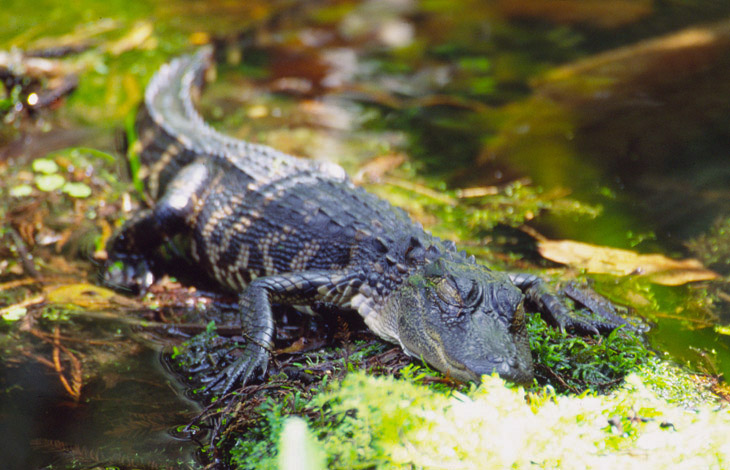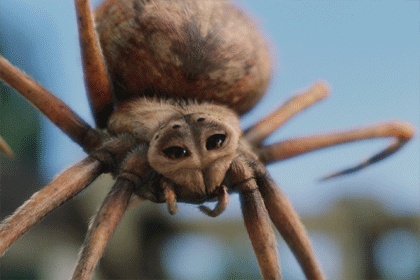There is a concept, a meme if you will, that shows up a lot in critical-thinking circles, and I’ve even tackled it a few times before here. Commonly known as “Occam’s Razor” but also by the less folksy term of parsimony, it provides a very simple measuring stick: if multiple explanations can be advanced for any given facts or events, the simplest is usually the correct one. What it tells us is not to seek complication when trying to find out how something happens; the more complicated something is, the more likely it is to leave traces of this complication behind. Very few things happen without a trace of evidence. If we have a theory that fails to account for any given detail, the theory is probably wrong, or at least incomplete – that detail had to come from somewhere. But at the same time, if we have a complicated theory without accompanying complicated evidence, that theory is probably wrong as well – not only does every effect have a cause, but every cause has an effect.
When it comes to paranormal topics, however, problems can arise. By paranormal I refer to such topics as extra-terrestrial visitation (which is more specific than UFOs,) psychic powers, faith healing, ghosts, and so on – essentially, any topic where the phrase, “science doesn’t know everything,” is used as both justification and a battle cry. The problem is two-pronged, and one of those prongs is often not even recognized. On the face of it, the existence of Bigfoot is a very simple explanation for all of the myriad sightings, the footprint casts, the blurry photos and videos, and the reports of weird calls in the night, as well as many other items. An unknown intelligence with hypertechnology is a very simple explanation for radar traces, fast-moving lights, and the car not being able to start. On the face of it, paranormal explanations are indeed the simplest connection to all of the facets reported. Or at least, might be if word count is the main criteria of, “simplest.”
It’s extremely easy to say, “Bigfoot,” (try it, you’ll see,) but Bigfoot is not a simple concept. What did this creature evolve from, what is its closest living relative, what does it eat, where does it sleep, how come we’ve never found a carcass, why does it depart so far from the hominids of the past few hundred thousand years, did it come onto the continent separately from humans, how many are needed for reproductive stability? And so on, and so forth – there’s a lot of baggage when it comes to proposing an entirely new species based on rather flimsy evidence, evidence that fails to answer any of these questions and most others as well; “big” and “hairy” do not really portray a robust theory. The same kind of questions can be asked of any other “simple” explanation, especially if we consider that the advancement of scientific knowledge is the aim, rather than the typical lofty goal of winning an argument.
[I will take a moment to address the common response at this point, which is to argue that any such proposal “might be possible.” It might also be possible that the proposal is utter horseshit, as well, and in fact this is far more likely in damn near every such situation – but, curiously, you won’t find a fraction of the effort spent towards ruling this out, even though you’d think that would be the first step, wouldn’t you?]
But the second prong of the problem is a little thing called conflation. While a radar trace, a light in the sky, and the car not starting are all considered evidence, how does one determine that these belong together in any way? Has any effort been made to tie the radar trace to the light’s position firmly enough that they can be considered linked? I mean, there are always lights in the sky. How about the position of the light to the location of the car? How close is “close enough,” especially considering that in most situations, within a half-kilometer radius there could be anything from dozens to hundreds of other cars? How are all of the myriad known causes of a car not starting ruled out first? What mechanism is proposed to prevent a car from starting without physical interference? The military of any country would be exceptionally interested in this explanation. It is assumed that this is a property of alien spacecraft, simply because they’re often reported together, but the reasoning and the physics behind this are left hanging, somehow unnecessary to fill in at all. And if the answer to any such question is along the lines of, “Magic, super-high technology that we haven’t discovered yet,” that effectively translates to, “I don’t know,” and thus no differentiation from random, unconnected events has actually been established.
The same may be said for Bigfoot. Someone heard a weird noise in the woods at night? Yeah, welcome to the woods, a lot goes on here – I’m sure you can identify a raccoon squabble, the mating call of a red fox, and the cry of a captured treefrog, to rule out all of these, and every other known denizen of the forest. Tracks, you say? So, they exhibit the flexing, hip torsion, and toe separation of a bipedal hominid, and not just the easily-faked flat ‘bootprint’ impression of a standing foot, right? You’re aware that wildlife biologists routinely perform population counts in remote areas with the advanced technology of game cameras, so establishing more details about such a species would be relatively easy, of course.
This kind of ‘evidence’ is presented all of the time. “This house is haunted; it often creaks at night for no reason!” Oh, so ghosts, defined by having no physical presence whatsoever, now have enough mass to make the floorboards flex in an aging structure? “No, but wait: someone died here!” Yeah, that’s never gonna happen for an old house. Someone has died on some stretch of road we drive frequently too – be careful of the car stalling out. No, wait, that’s aliens…
It’s funny. We have a likely-evolved trait to work things out, to find the patterns, to seek the cause-and-effect function everywhere, and this is no bad thing, because it’s responsible for everything that we call ‘knowledge’ in the first place. But it’s not quite complete. We have a wicked tendency to fixate on a potential cause, often in complete disregard of its plausibility, and then try to jam in supporting evidence while ignoring everything that fails to fit, or disproves it. In many cases, facts are grabbed at will, becoming ‘evidence’ for the favored cause even when no relation can be found. If we want to find support for any given scenario, and are not encumbered by either having to show distinct relevance, nor in demonstrating that they could not originate from mundane causes, then we can always find plenty of things that meet those low standards. For those who adore conspiracies, the sole criteria is, “something that appears odd.”
One of the most functional aspects of scientific endeavors, one that would be of inestimable value if introduced to kids early on, is the concept of ruling out wrong answers and mistakes. Sure, it appears that R is caused by A – but are we sure it’s not caused by C, H, or M? Can we demonstrate this? And so, the consideration of alternate scenarios becomes a prime activity, as well as the consideration that factors Q and U have no demonstrable relation to the result at all.
[I have to add in another aside. Cultural influences are pernicious little things that abound in such discussions as well, often assumed to have some relation even though nobody actually knows how or why. While very few people reading this have had any personal experience with aliens or Bigfoot, we all ‘know’ what they look like, don’t we? And why the fucking hell would extra-terrestrials with such advanced technology have to display anti-collision lights? It usually takes real effort to tackle these ‘common knowledge’ aspects and recognize them for unwarranted assumptions, repeated ad nauseum throughout every form of media.]
I have heard, on more than one occasion, the phrase, “You just have different standards of evidence than I do.” First off, recognize that this is a complaint about someone’s standards being too high. But more to the point, this isn’t really a matter of personal opinion – evidence can only be for one thing, even though we’re often unsure what that one thing is. Most of the time, we’re being told this is evidence for something that has never been proven, has no firm criteria or often even a definition, and cannot be replicated on demand. That’s a bit problematic all by itself, but it gets much worse when the vast majority of this evidence could also be produced by mundane means. Sure, it could be from real psychic, precognitive powers, but it could also be produced by cold-reading, which we have ample evidence of and can be taught to someone within a day, which has even been proven as the modus operandi of a large number of self-professed ‘psychics.’ Since cold-reading is common and real precognition has never been established, the odds are heavily (as in, entirely) in favor of cold-reading. In such a case, we’re not even talking standards, but the bare necessity of ruling out the thing that exists before proposing the thing that doesn’t. Avoiding this is not just showing a bias towards psychic powers, but also a distinct lack of trust in them – someone convinced that they exist would have no hesitation in putting them to the most stringent tests possible, rather than arguing that the standards are too high.
One of the guidelines that I’ve used as a challenge has been to think of the topic as a court case; the prosecution must prove beyond a reasonable doubt that their case is solid. There’s a slight downside to this, in that “reasonable doubt” is too broadly subjective, but there’s also the other aspect that prompts diligence: that an opposing attorney is going to look for any manner possible to rip the case the shreds. “Did the witness remain in a fixed location and plot the movement of the light in the sky against firm and measurable landmarks?” “Were there any other witnesses to this event that the witness on the stand is now selling their account of to magazines for a tidy fee?” Faced with such inquiries, the typical promoter of paranormal explanations insists that “skeptics are just trying to dismiss the whole thing,” but the point really is, if the doubt can be sown so easily, what does this say about the quality of the supposed evidence? No belief in extraordinary properties should have to rely on whether someone is favorably disposed to it or not. The case should be built against such doubt, not in denial or avoidance of it.




















































 Gosh, it’s been, what, six whole hours since I’ve posted anything about the resident mantids? I cannot apologize enough – I know how you must feel.
Gosh, it’s been, what, six whole hours since I’ve posted anything about the resident mantids? I cannot apologize enough – I know how you must feel.
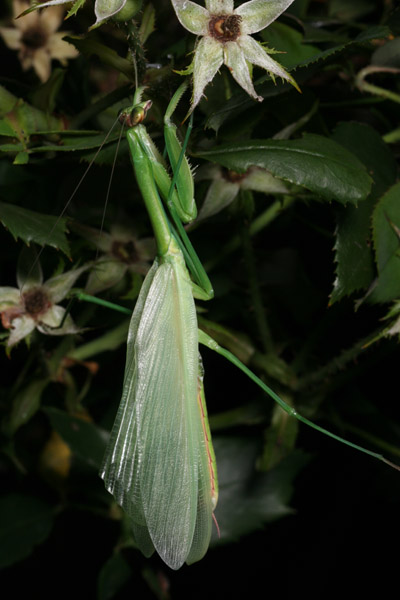 The Chinese mantis (Tenodera aridifolia sinensis) on the rose bush was found during a watering session around midnight the other night, displaying the newly extended wings from a recent molt. They’re still not dry in this photo, which is why they appear a little unkempt; they’re also paler than they will be when dry, which we’ll get to shortly. The wings don’t become this big, or functional, until the final instar, the reproducing adult phase, so now the quest is on to find a mate.
The Chinese mantis (Tenodera aridifolia sinensis) on the rose bush was found during a watering session around midnight the other night, displaying the newly extended wings from a recent molt. They’re still not dry in this photo, which is why they appear a little unkempt; they’re also paler than they will be when dry, which we’ll get to shortly. The wings don’t become this big, or functional, until the final instar, the reproducing adult phase, so now the quest is on to find a mate.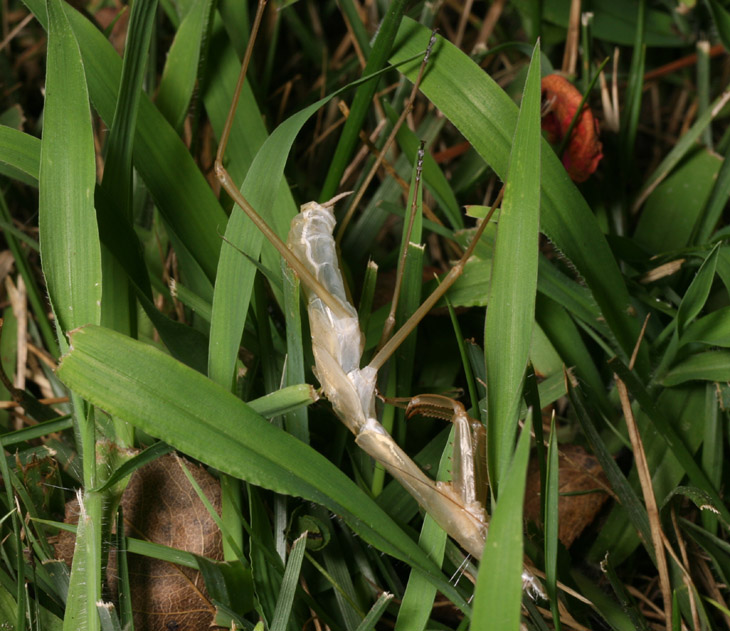
 Ten hours later, the wings were dry and displaying the adult coloration, as well as presumably being functional – I am guessing this is a female who will be waiting for an acceptable male to find her, especially since she seems to like the rose bush. I am not going to discourage this in any way, since it would be easy to find an egg sac should she place it there, and may well give me the opportunity to photograph her producing it. Measured just now for this post, the mantis is about 86mm in length (3.5 inches) from the head to the wingtips, quite a change from the 10mm that they typically are when hatched. She won’t get a whole lot bigger than this, though she (if I have the sex right) will get considerably broader until producing the eggs. Keep checking back with me, and we’ll see what happens.
Ten hours later, the wings were dry and displaying the adult coloration, as well as presumably being functional – I am guessing this is a female who will be waiting for an acceptable male to find her, especially since she seems to like the rose bush. I am not going to discourage this in any way, since it would be easy to find an egg sac should she place it there, and may well give me the opportunity to photograph her producing it. Measured just now for this post, the mantis is about 86mm in length (3.5 inches) from the head to the wingtips, quite a change from the 10mm that they typically are when hatched. She won’t get a whole lot bigger than this, though she (if I have the sex right) will get considerably broader until producing the eggs. Keep checking back with me, and we’ll see what happens.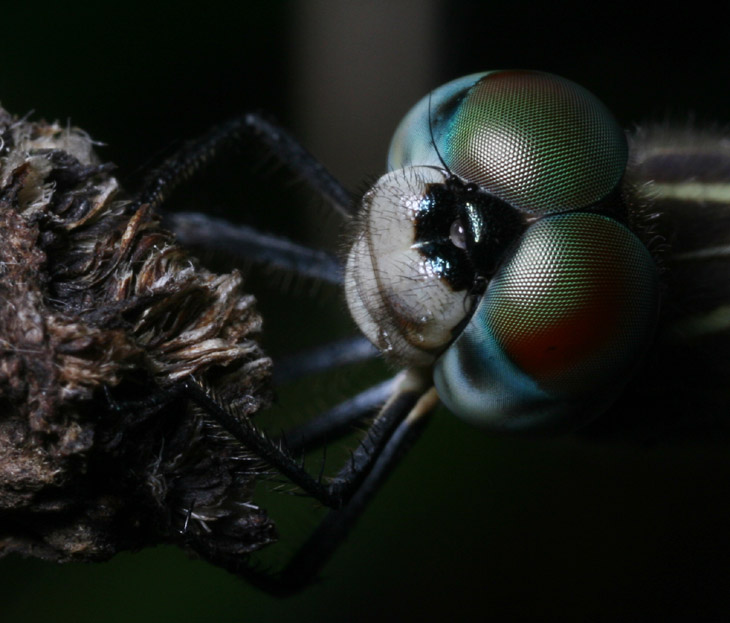
 The other night, a Copes grey treefrog (Hyla chrysoscelis) was found clinging to the stem of a cherry tomato plant on the deck, producing a pose that seemed to be evocative of something, but I haven’t pinned down what – perhaps I should hold a caption contest (you might as well send one in – with the dearth of comments you’re pretty much guaranteed to win something.)
The other night, a Copes grey treefrog (Hyla chrysoscelis) was found clinging to the stem of a cherry tomato plant on the deck, producing a pose that seemed to be evocative of something, but I haven’t pinned down what – perhaps I should hold a caption contest (you might as well send one in – with the dearth of comments you’re pretty much guaranteed to win something.) I am identifying this as a Copes grey treefrog, but visually, they are impossible to tell apart from a common grey treefrog; the reason I offer this identification with such supreme and unflagging confidence is that, from the calls that I hear during the rainy nights, this is the only species that seems to be in the area. Copes have a
I am identifying this as a Copes grey treefrog, but visually, they are impossible to tell apart from a common grey treefrog; the reason I offer this identification with such supreme and unflagging confidence is that, from the calls that I hear during the rainy nights, this is the only species that seems to be in the area. Copes have a 


 And finally, it’s not a complete week without spiders, so I offer a subtle crab spider hanging out on a pokeweed blossom. This one is considerably larger than
And finally, it’s not a complete week without spiders, so I offer a subtle crab spider hanging out on a pokeweed blossom. This one is considerably larger than  So, for this Monday color we have an image that’s faintly unsettling to me. Not for any peculiar associations I have with the Digitalis family (though in truth we haven’t gotten along since that incident at the airport,) but because the color seems off, and not able to be corrected in any way. It has the appearance of something that had originally been shot in monochrome, like in the ’40s, and was later colorized – just not quite there, not ringing true. For instance, look at the leaves and stems at the base of the blooms; that hue of green lacks vibrancy and authenticity. In most cases when seeing this, I would tweak the color away from blue, but then that seems to change the color of the blossoms away from an accurate rendition of those. And it’s possible that the greens of this particular plant really were this hue.
So, for this Monday color we have an image that’s faintly unsettling to me. Not for any peculiar associations I have with the Digitalis family (though in truth we haven’t gotten along since that incident at the airport,) but because the color seems off, and not able to be corrected in any way. It has the appearance of something that had originally been shot in monochrome, like in the ’40s, and was later colorized – just not quite there, not ringing true. For instance, look at the leaves and stems at the base of the blooms; that hue of green lacks vibrancy and authenticity. In most cases when seeing this, I would tweak the color away from blue, but then that seems to change the color of the blossoms away from an accurate rendition of those. And it’s possible that the greens of this particular plant really were this hue. Most of the time recently, the skies are so clear at sunrise that they’re boring, lacking in rich colors and clouds to throw some textures into the mix. But this morning looked like it was going to be different, so I trotted over to the pond to see what would develop as the sun came into view. While the sky did not quite produce the qualities that I was hoping for, I received the cooperation of a double-crested cormorant (Phalacrocorax auritus) which has taken up residence in the pond now, sharing it with a great blue heron or two, a green heron, and a cluster of Canada geese.
Most of the time recently, the skies are so clear at sunrise that they’re boring, lacking in rich colors and clouds to throw some textures into the mix. But this morning looked like it was going to be different, so I trotted over to the pond to see what would develop as the sun came into view. While the sky did not quite produce the qualities that I was hoping for, I received the cooperation of a double-crested cormorant (Phalacrocorax auritus) which has taken up residence in the pond now, sharing it with a great blue heron or two, a green heron, and a cluster of Canada geese.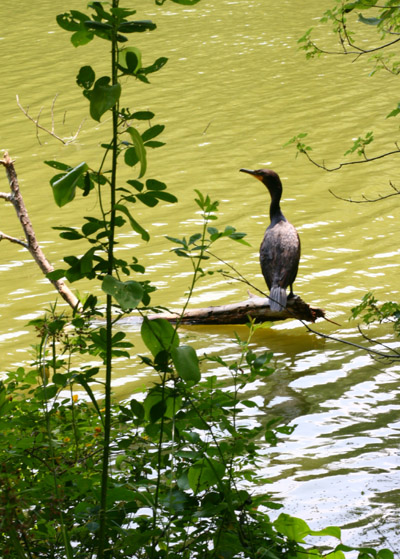 A few days back when I’d first spotted the cormorant, it was sitting quite close to shore on a log, and wasn’t terribly concerned with my presence, though it was plainly aware of me and likely would have preferred that I not be around. So far everything I’ve been able to get has been backlit, which is a shame, because cormorants have the most brilliant jade green eyes. It’s curious, actually; most of the raptors have yellow or brown eyes, and for the songbirds brown is the norm. Sandhill cranes have orange eyes, white ibis have blue, wood ducks have red, but cormorants are the only ones with green eyes to my knowledge (which, it must be said, is not comprehensive by any stretch.) If I don’t manage to get any close and well-lit shots showing the eyes soon, I’ll dig out some slides that I have which illustrates the color nicely. In fact, probably much better than the digital camera does – the color register of Fuji Provia and Velvia film beats the hell out of any digital camera or setting that I’ve come across, and if I had the ability to process it at home conveniently, I’d probably be using film more often. As it is, it’s getting difficult to find processing services, and more expensive – at some point I’ll do a post about “convenient mediocrity.”
A few days back when I’d first spotted the cormorant, it was sitting quite close to shore on a log, and wasn’t terribly concerned with my presence, though it was plainly aware of me and likely would have preferred that I not be around. So far everything I’ve been able to get has been backlit, which is a shame, because cormorants have the most brilliant jade green eyes. It’s curious, actually; most of the raptors have yellow or brown eyes, and for the songbirds brown is the norm. Sandhill cranes have orange eyes, white ibis have blue, wood ducks have red, but cormorants are the only ones with green eyes to my knowledge (which, it must be said, is not comprehensive by any stretch.) If I don’t manage to get any close and well-lit shots showing the eyes soon, I’ll dig out some slides that I have which illustrates the color nicely. In fact, probably much better than the digital camera does – the color register of Fuji Provia and Velvia film beats the hell out of any digital camera or setting that I’ve come across, and if I had the ability to process it at home conveniently, I’d probably be using film more often. As it is, it’s getting difficult to find processing services, and more expensive – at some point I’ll do a post about “convenient mediocrity.”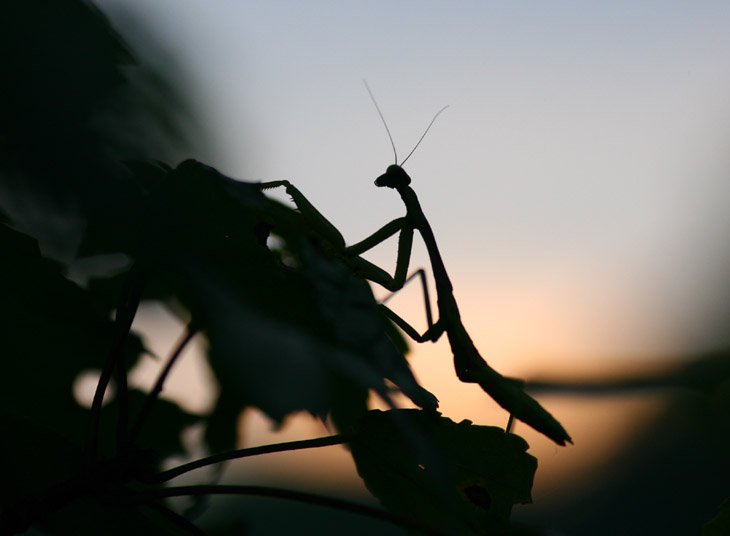
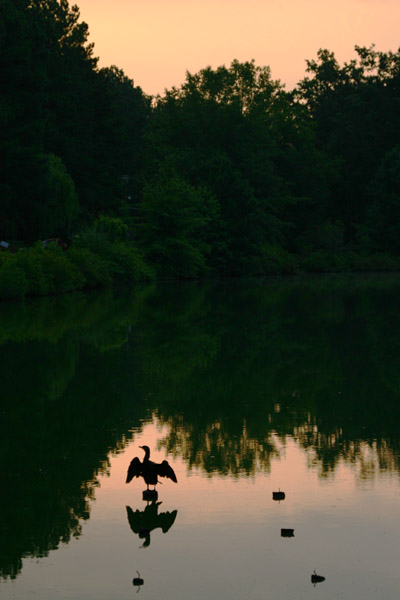 I’ll leave you with another version of the cormorant poses – still trying to decide which one I like the best. This one was tweaked a little to bring the background trees slightly brighter, giving a little more texture to the whole image. I’m wondering if I should have tried using fill-flash for this one as well, to bring out a little detail from the bird rather than rendering it a simple silhouette, but I’m not sure the flash would have produced enough light for that distance. I need to think about these things while I’m shooting, though, and not afterward when I’m looking at the images…
I’ll leave you with another version of the cormorant poses – still trying to decide which one I like the best. This one was tweaked a little to bring the background trees slightly brighter, giving a little more texture to the whole image. I’m wondering if I should have tried using fill-flash for this one as well, to bring out a little detail from the bird rather than rendering it a simple silhouette, but I’m not sure the flash would have produced enough light for that distance. I need to think about these things while I’m shooting, though, and not afterward when I’m looking at the images…
